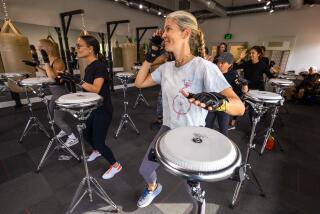Mental Fitness Class Keeps Brains in Shape
DENVER â The students in Bonnie Fullerâs fitness class sit with their arms folded in their laps, listening to Bach.
Their eyes close as the teacher asks them to imagine walking past an orchard and eating a peach on a sunny day. The baroque music is 60 beats per minute, the same pattern as alpha waves in the brain that are thought by some to be its optimal learning state.
Fuller wants the students, in their 60s and 70s, to sharpen their senses, the brainâs main source of information, since they can become less keen with age.
The senses are one way her class, called âGrow Dendrites Forever,â tries to help older people keep their brains in shape. Students are taught to constantly try new things--cooking with curry, say--so their brain cells can grow.
âYou need to learn something new,â Fuller said. âLearn how to play the harmonica . . . to square dance . . . to speak Spanish.â
By taking 20 minutes a day to stretch their brains, students learn they can promote the growth of dendrites, which help brain cells communicate, and help maintain long- and short-term memory.
Everything in the class is tailored to stimulate the brain.
The covers of the workbooks are yellow, the most complex color, and Fuller encourages students to doodle in them with colored markers. She even tells them to sniff the markers--each color has a different smell.
Students introduce themselves in an alliterative sentence describing their brains.
âMy name is Wanda and my brain is wacky, wandering and wonderful,â said 69-year-old student Wanda Adams of Thornton.
Although there are no studies showing what effect these exercises have on human brains, research on animals shows that it is possible to grow dendrites, the branches of brain cells that receive messages from other brain cells, by keeping the brain active.
Studies on animals also have shown the brain is not a hard-wired machine that stops growing early in life but that it can continue to change and develop.
But Bill Thies, vice president for medical and scientific affairs for the Alzheimerâs Assn., said there still is not enough proof showing how growing more dendrites affects peopleâs behavior.
Marian Diamond, an integrative biology professor at UC Berkeley, has found that rats grow more dendrites when they have lots of toys and other rats to play with. She thinks the same applies to humans.
âItâs true with nerve cells, muscles and brains. They get bored. With the same thing always coming in they donât respond,â said Diamond.
She said the value of growing dendrites can be seen in an ongoing study of the brains of an order of Minnesota nuns who kept mentally active throughout their lives. Those nuns found to have Alzheimerâs disease upon their death did not exhibit symptoms while they were alive because there were plenty of dendrites to make up for the ones attacked by the disease.
Robert Friedland, a neurology professor at Clevelandâs Case Western Reserve University, is not sure how much doing brain exercises later in life can help people prevent Alzheimerâs.
âItâs good for these people to be active. But whatâs important is what they do over the many decades of their lives,â he said.
Adams has been keeping busy her entire life but said she wants to keep trying new things, like the brain fitness class. She worked on a farm until her husband died, leaving her to support their daughter. She also worked at various jobs, from teacherâs aide to explosives operator at an ammunitions plant.
Friedland says that people who are physically and mentally active throughout their lives are three times less likely to get Alzheimerâs.
âThe brain is an organ, just like any other in the body, that ages in regard to how itâs used,â he said.
*
On the Net:
National Institute of Mental Healthâs article, âNeural Activity Shapes the Brainâs Cellsâ:
https://www.nimh.nih.gov/sciadvances/09.cfm
National Institute on Aging:
https://www.alzheimers.org/






